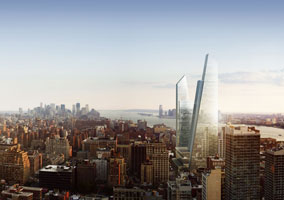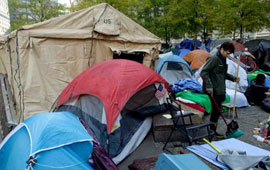Trending
The Real Deal staff’s picks for top real estate stories of 2011
We look back at Occupy Wall Street, Europe’s debt crisis, major deals and booming brokerages

New York real estate faced a whirlwind year in 2011, and numerous contenders surfaced when The Real Deal sat down to pick our favorite stories of the year.
There was the limping recovery of the residential sales market, coupled with several standout deals and the runaway revival of the rental market. Developers snapped up distressed properties, such as One Madison Park, while other stalled projects like the Azure cond-op tower came back to life.The vacancy rate in the Manhattan office market tightened over the course of the year, while the investment sales market recovered somewhat — the total value in 2011 is expected to hit $25 billion, nearly double the level in 2010.
Renovations at the Hotel Chelsea got underway, at one point taking a violent turn, while the Chetrit Group recently moved to evict longtime tenants at the iconic hotel.
In the meantime, Dominique Strauss-Kahn, the former head of the International Monetary Fund who was accused of sexual assault, could not escape house arrest at 153 Franklin Street soon enough.
But at the end of the day, the 10 stories below were the most memorable and most impactful of 2011. Check out our picks, listed in alphabetical order, below.
CMBS market breaks down
The market for commercial mortgage-backed securities, or CMBS, seemed to be in recovery mode at the start of the year, with many observers anticipating the value of the market would climb as high as $50 billion in 2011, up from $13 billion in 2010.
But in July, as Goldman Sachs and Citigroup were preparing the $1.5 billion sale of a group of CMBS, partly secured by New York City properties, the ratings agency Standard & Poor’s said it would need to reevaluate the mortgages backing the bonds, effectively killing the deal and throwing the market into upheaval.
Through the spring and summer, CMBS delinquency rates continued to worsen. In October, Credit Suisse said it would shutter its CMBS division, after restarting the unit in 2010.
Condé Nast leases at One World Trade Center

A rendering of One World Trade
In May, magazine publisher Condé Nast signed on to lease 1 million square feet of office space at One World Trade Center, giving up its space at 4 Times Square for the building’s 20th through 41st floors and providing further evidence of the Financial District’s recovery. CBRE brokers Mary Ann Tighe, CEO of the New York tri-state region, and Gregory Tosko, the vice chairman, represented Condé Nast. Tara Stacom, vice chairman at Cushman & Wakefield, represented the Port Authority of New York & New Jersey.
The publisher’s annual rent is estimated at just over $60 per square foot, or about $2 billion over the course of a 25-year lease starting in 2014. In exchang, the Port Authority agreed to pay Condé Nast’s rent at its former space through 2019, among other incentives.
Roughly half of the tower’s 3 million square feet is now leased, with the U.S. General Services Administration and China’s Vantone Industrial inking deals for about 300,000 and 200,000 square feet, respectively.
Meanwhile, construction workers hurried to complete as much of the 16-acre site as possible in advance of the 10th anniversary of the Sept. 11 terrorist attacks. As of earlier this month, when One World Trade Center was lit up with colored lights for the holidays, steel installation had reached 90 of the 104 stories, while the glass façade was 65 stories high.
Donald Trump eyes political seat

Donald Trump
Between his aborted presidential bid, a campaign to force President Barack Obama to produce his longform birth certificate, and the publication of the policy manifesto, “Time to Get Tough: Making America #1 Again,” developer Donald Trump has had a busy year in the political spotlight.
The real estate tycoon made headlines in the spring as a frontman for the birther movement, which he claimed would help sales at his condominium projects. He then toyed with making a run as the Republican presidential nominee. (He scrapped that idea in May.)
Trump later refashioned himself as a GOP kingmaker, meeting with Mitt Romney, Newt Gingrich and other Republican presidential candidates, and planning to moderate a GOP debate. He backed out of the debate when only two of the contenders — Gingrich and Rick Santorum — said they would show up.
In an about-face last week, Trump rebuffed the Republicans by moving to switch his party affiliation to “unaffiliated.” But don’t bet on the developer disappearing from the national political scene in 2012: he has reportedly said he would consider running on a third-party ticket.
Europe’s debt woes cross the pond
The European debt crisis dominated headlines in 2011, as first Greece, then other euro zone nations like Italy and Spain tottered on the brink of default. Closer to home, the turmoil brought mixed news for Manhattan’s residential real estate market.
On the one hand, some international buyers saw New York as a safer bet than investing in real estate back home. Russians plowed money into glitzy Manhattan spreads, notably media mogul Igor Krutoy, who spent $48 million on a pied-a-terre at The Plaza, and the daughter of businessman Dmitriy Rybolovlev, who reportedly snapped up Sanford Weill’s $88 million penthouse at 15 Central Park West.
On the other hand, the crisis spooked local buyers, who scoped out the rollercoaster-like movements of the stock market — which seemed to rise and fall on every snippet of news coming out of Europe — and adopted a “wait-and-see” attitude when it came to acquiring Manhattan co-ops and condominiums.
Hudson Yards welcomes Coach

A rendering of the Hudson Yards Related Companies CEO Stephen Ross and President Jeff Blau announced in November that luxury accessories retailer Coach would anchor about 600,000 square feet of the first building planned for the mammoth Hudson Yards project on Manhattan’s West Side. CBRE’s Tighe and Tosko represented Coach in the transaction.
Though Coach was the first tenant unveiled, Related has released further details about the 26-acre site over the course of 2011. Last summer, architect William Pedersen, vice chairman of Kohn Pedersen Fox Associates, rejiggered the overall design, axing one of the three buildings in favor of two diagonally sloping towers, at 51 and 67 stories. The mixed-use project will encompass office space, residential units, an arts center named the Culture Shed and the extension of the No. 7 subway line.
Hurricane Irene blows into town
One of the biggest stories of 2011 turned out to be something of a non-event, at least for Manhattan’s commercial landlords. Though Hurricane Irene prompted evacuations in low-lying areas of the city, including Lower Manhattan, and inflicted heavy damage on parts of New Jersey and elsewhere, the August weather snafu reportedly caused minimal problems for the city’s high-rises.

Hurricane Irene
The Port Authority reported only minor damage at the World Trade Center site, including some flooding in the basement of One World Trade Center, according to Crain’s, while the city’s largest landlord, SL Green Realty, said there were leaks at a few of the buildings in its 36-property portfolio.
Compared to the freak snowstorm that blew through the northeast in October, Irene was relatively mild.
Still, the threat of a more serious storm prompted concerns from industry insiders about the vulnerability of waterfront properties. Likewise, the mini-earthquake that closely preceded Irene called attention to the stability of the city’s aging building stock.
Jones Lang LaSalle, others capture new talent

Mitchell Konsker, vice chairman at Jones Lang LaSalle Jones Lang LaSalle may be a major global brokerage, but its New York presence is less hefty. In the last year, however, the firm went on a hiring spree, most notably luring five top leasing brokers — Mitchell Konsker, Matthew Astrachan, Paul Glickman, Mitti Liebersohn and Alexander Chudnoff — from Cushman & Wakefield. (This was after Jones Lang hired the team of Richard Baxter, Scott Latham, Yoron Cohen and Jonathan Caplan from Cushman in May 2010.)
Colliers International also beefed up its ranks in 2011, snagging at least a half dozen agents from companies like CBRE and NAI Global. At the same time, Colliers shuffled its New York leadership, replacing the CEO of its tri-state office, Mark Jaccom, with Michael Cohen, the grandson of Williams Real Estate co-founder Victor Cohen.
In other brokerage news, two residential firms ballooned in 2011, namely Town Residential and Keller Williams NYC. The fastest-growing residential brokerage in Manhattan, Town expanded to 265 agents and staff in its first year in business, while the local franchise of Keller Williams Realty grew by more than 130 agents since launching in April.
New York gambles on first casino

Rendering of the “racino” In October, New York’s first casino opened at the Aqueduct racetrack in South Ozone Park, Queens, bringing in 65,000 patrons on its first weekend, according to operator Resorts World Casino. The $880 million “racino,” roughly 10 years in the making, skirted New York state’s ban on full-fledged casinos by offering electronic slot machines and staffing game tables with robotic arms.
One57 goes sky-high

A rendering of One57
Even before Extell Development Company officially kicked off sales at One57 in December, news of the developer’s sky-high asking prices drummed up buzz for the 90-story Condominium Tower On West 57th Street between Sixth and Seventh avenues. First, the $90.5 million and $98.5 million price tags on the tower’s two sprawling penthouses raised eyebrows. Then, as The Real Deal reported, prices on the remaining 93 units, which ranged from $3,000 to $8,285 per square foot, prompted industry experts to compare One57 to 15 Central Park West. And earlier today, the Wall Street Journal reported that Extell had raised the penthouse price tags even further — to $105 million and $110 million.
Whether anyone will pay these sums remains to be seen. The 1,000-foot building, which will house a Park Hyatt hotel on its first 30 stories, is set to eclipse New York by Gehry at 8 Spruce Street as the city’s tallest residential tower. (The 1,776-foot One World Trade Center, also under construction, is slated to be New York’s tallest building when complete, while Marriott International is planning the city’s tallest standalone hotel tower at 1717 Broadway.)
Wall Street (and elsewhere) gets occupied
When demonstrators started camping out in the Financial District’s Zuccotti Park in September, it seemed far-fetched that the protest against economic injustice would inspire copycat movements as far afield as Oakland, Calif., Paris and Seoul — or that some of New York’s biggest real estate names would find themselves in the crosshairs of Occupy Wall Street.

Zuccotti ParkAs the owner of Zuccotti Park, Brookfield Properties was front and center. (Its U.S. chairman, John Zuccotti, leant his name to the park.) The company initially did not enforce a ban on camping equipment in the park, and called off a planned cleanup Oct. 14. But eventually, Brookfield asked the city to step in, and on Nov. 16, Mayor Michael Bloomberg ordered police to clear the encampment.
No doubt some local businesses were overjoyed to see the last of the protesters, but it was too late for Milk Street Café, which blamed its closing in mid-December on the occupiers.
While Zuccotti Park may have been the epicenter of the Occupy movement, protesters fanned out across Manhattan and Brooklyn to voice their concerns. Real estate developer Howard Milstein and John Angelo, CEO of Angelo, Gordon & Co., were the target of a “Millionaire’s March” Oct. 11, when demonstrators rallied outside the homes of corporate executives including Rupert Murdoch, the founder of News Corp., and Jamie Dimon, the CEO of JPMorgan Chase.
Meanwhile, later in October, protesters took aim at the Real Estate Board of New York, urging supporters via Twitter to “occupy” the trade group after it floated an idea to allow building owners to close down “privately owned public spaces” like Zuccotti Park overnight. In December, activists marched to Brooklyn to speak out against underhanded foreclosure practices.




